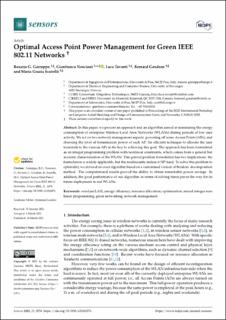| dc.contributor.author | Garroppo, Rosario G. | |
| dc.contributor.author | Nencioni, Gianfranco | |
| dc.contributor.author | Tavanti, Luca | |
| dc.contributor.author | Gendron, Bernard | |
| dc.contributor.author | Scutellà, Maria Grazia | |
| dc.date.accessioned | 2021-05-03T07:53:41Z | |
| dc.date.available | 2021-05-03T07:53:41Z | |
| dc.date.created | 2021-03-16T13:19:15Z | |
| dc.date.issued | 2021-03 | |
| dc.identifier.citation | Garroppo, R. G., Nencioni, G., Tavanti, L. et al. (2021) Optimal Access Point Power Management for Green IEEE 802.11 Networks. Sensors, 21(6) | en_US |
| dc.identifier.issn | 1424-8220 | |
| dc.identifier.uri | https://hdl.handle.net/11250/2740716 | |
| dc.description.abstract | In this paper, we present an approach and an algorithm aimed at minimising the energy consumption of enterprise Wireless Local Area Networks (WLANs) during periods of low user activity. We act on two network management aspects: powering off some Access Points (APs), and choosing the level of transmission power of each AP. An efficient technique to allocate the user terminals to the various APs is the key to achieving this goal. The approach has been formulated as an integer programming problem with nonlinear constraints, which comes from a general but accurate characterisation of the WLAN. This general problem formulation has two implications: the formulation is widely applicable, but the nonlinearity makes it NP-hard. To solve this problem to optimality, we devised an exact algorithm based on a customised version of Benders’ decomposition method. The computational results proved the ability to obtain remarkable power savings. In addition, the good performance of our algorithm in terms of solving times paves the way for its future deployment in real WLANs. | en_US |
| dc.language.iso | eng | en_US |
| dc.publisher | MDPI | en_US |
| dc.rights | Navngivelse 4.0 Internasjonal | * |
| dc.rights.uri | http://creativecommons.org/licenses/by/4.0/deed.no | * |
| dc.subject | WLAN | en_US |
| dc.subject | trådløst LAN | en_US |
| dc.subject | nettverksstyring | en_US |
| dc.subject | energiforbruk | en_US |
| dc.title | Optimal Access Point Power Management for Green IEEE 802.11 Networks | en_US |
| dc.type | Peer reviewed | en_US |
| dc.type | Journal article | en_US |
| dc.description.version | publishedVersion | en_US |
| dc.rights.holder | © 2021 by the authors. | en_US |
| dc.subject.nsi | VDP::Teknologi: 500::Informasjons- og kommunikasjonsteknologi: 550 | en_US |
| dc.source.volume | 21 | en_US |
| dc.source.journal | Sensors | en_US |
| dc.source.issue | 6 | en_US |
| dc.identifier.doi | 10.3390/s21062076 | |
| dc.identifier.cristin | 1898348 | |
| dc.source.articlenumber | 2076 | en_US |
| cristin.ispublished | true | |
| cristin.fulltext | original | |
| cristin.qualitycode | 1 | |

